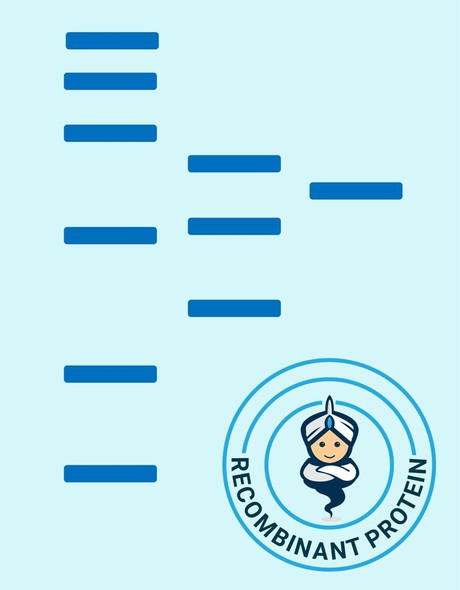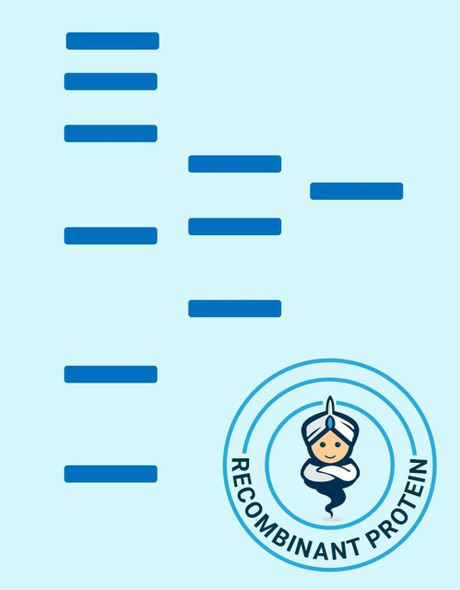Hormones Recombinant Proteins
Human OT Recombinant Protein (RPPB1348)
- SKU:
- RPPB1348
- Product Type:
- Recombinant Protein
- Species:
- Human
- Uniprot:
- P01178
- Research Area:
- Hormones
Description
| Product Name: | Human OT Recombinant Protein |
| Product Code: | RPPB1348 |
| Size: | 25mg |
| Species: | Human |
| Target: | OT |
| Synonyms: | OT, OXT, OT-NPI, Neurophysin 1, MGC126890, MGC126892. |
| Source: | Synthetic |
| Physical Appearance: | Sterile Filtered White lyophilized (freeze-dried) powder. |
| Formulation: | The Oxytocin was lyophilized from a concentrated (1mg/ml) solution with no additives. |
| Solubility: | It is recommended to reconstitute the lyophilized Oxytocin in sterile 18M?-cm H2O not less than 100 �g/ml, which can then be further diluted to other aqueous solutions. |
| Stability: | Lyophilized Oxytocin although stable at room temperature for 3 weeks, should be stored desiccated below -18°C. Upon reconstitution Neurophysin 1 should be stored at 4°C between 2-7 days and for future use below -18°C.For long term storage it is recommended to add a carrier protein (0.1% HSA or BSA).Please prevent freeze-thaw cycles. |
| Purity: | Greater than 99.0% as determined by RP-HPLC. |
| Amino Acid Sequence: | Cys-Tyr-Ile-Gln-Asn-Cys-Pro-Leu-Gly-NH2 |
Human Oxytocin stimulates uterine smooth muscle contractions indirectly and stimulates the mammary glands to increase lactation without increasing the production of milk.
Oxytocin Human Synthetic is a single, non-glycosylated, polypeptide chain containing 9 amino acids and having a molecular mass of 1007.2 Dalton. Oxytocin has a molecular formula of C43H66N12O12S2. The OT is purified by proprietary chromatographic techniques.
| UniProt Protein Function: | OXT: Neurophysin 1 specifically binds oxytocin. Belongs to the vasopressin/oxytocin family. |
| UniProt Protein Details: | Protein type:Secreted; Secreted, signal peptide Chromosomal Location of Human Ortholog: 20p13 Cellular Component: extracellular region Biological Process: signal transduction |
| NCBI Summary: | This gene encodes a precursor protein that is processed to produce oxytocin and neurophysin I. Oxytocin is a posterior pituitary hormone which is synthesized as an inactive precursor in the hypothalamus along with its carrier protein neurophysin I. Together with neurophysin, it is packaged into neurosecretory vesicles and transported axonally to the nerve endings in the neurohypophysis, where it is either stored or secreted into the bloodstream. The precursor seems to be activated while it is being transported along the axon to the posterior pituitary. This hormone contracts smooth muscle during parturition and lactation. It is also involved in cognition, tolerance, adaptation and complex sexual and maternal behaviour, as well as in the regulation of water excretion and cardiovascular functions. [provided by RefSeq, Dec 2013] |
| UniProt Code: | P01178 |
| NCBI GenInfo Identifier: | 128071 |
| NCBI Gene ID: | 5020 |
| NCBI Accession: | P01178.1 |
| UniProt Secondary Accession: | P01178,Q3MIG0, |
| UniProt Related Accession: | P01178 |
| Molecular Weight: | 12,722 Da |
| NCBI Full Name: | Oxytocin-neurophysin 1 |
| NCBI Synonym Full Names: | oxytocin/neurophysin I prepropeptide |
| NCBI Official Symbol: | OXT�� |
| NCBI Official Synonym Symbols: | OT; OT-NPI; OXT-NPI�� |
| NCBI Protein Information: | oxytocin-neurophysin 1 |
| UniProt Protein Name: | Oxytocin-neurophysin 1 |
| UniProt Synonym Protein Names: | OxytocinAlternative name(s):Ocytocin |
| Protein Family: | Xylosyltransferase |
| UniProt Gene Name: | OXT�� |
| UniProt Entry Name: | NEU1_HUMAN |






